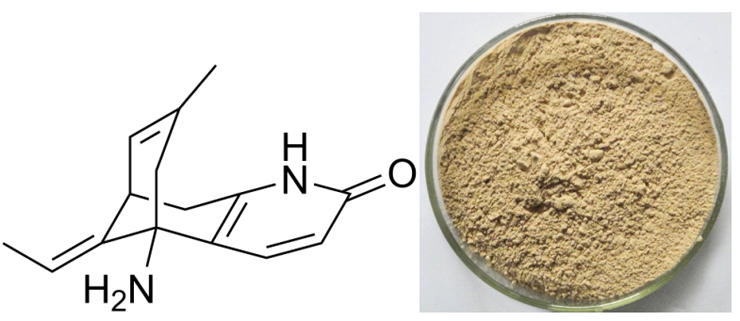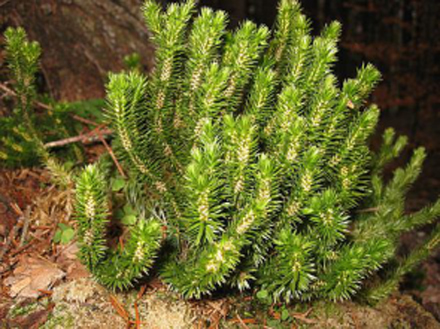Top Suppliers Huperzine A Factory from Albania
Top Suppliers Huperzine A Factory from Albania Detail:
[Latin Name]Huperzia serratum
[Source] Huperziceae whole herb from China
[Appearance]Brown to white
[Ingredient]Huperzine A
[Specification]Huperzine A 1% – 5%, HPLC
[Solubility] Soluble in chloroform, methanol, ethanol, slightly soluble in water
[Particle size] 80 Mesh
[Loss on drying] ≤5.0%
[Heavy Metal] ≤10PPM
[Pesticide residue] EC396-2005, USP 34, EP 8.0, FDA
[Storage] Store in cool & dry area, keep away from the direct light and heat.
[Shelf life] 24 Months
[Package] Packed in paper-drums and two plastic-bags inside.
[What is Huperzine A]
Huperzia is a type of moss that grows in China. It is related to club mosses (the Lycopodiaceae family) and is known to some botanists as Lycopodium serratum . The whole prepared moss was used traditionally. Modern herbal preparations use only the isolated alkaloid known as huperzine A. Huperzine A is an alkaloid found in huperzia that has been reported to prevent the breakdown of acetylcholine, an important substance needed by the nervous system to transmit information from cell to cell. Animal research has suggested that huperzine A’s ability to preserve acetylcholine may be greater than that of some prescription drugs. Loss of acetylcholine function is a primary feature of several disorders of brain function, including Alzheimer’s disease . Huperzine A may also have a protective effect on brain tissue, further increasing its theoretical potential for helping reduce symptoms of some brain disorders.
[Function] Used in alternative medicine, huperzine A has been found to act as a cholinesterase inhibitor, a type of medicine used to prevent the breakdown of acetylcholine (a chemical essential to learning and memory).
Not only used as a treatment for Alzheimer’s disease, huperzine A is also said to enhance learning and memory and to protect against age-related cognitive decline.
In addition, huperzine A is sometimes used to boost energy, increase alertness, and aid in the treatment of myasthenia gravis (an autoimmune disorder that affects the muscles).
Product detail pictures:

Related Product Guide:
We now have a highly efficient crew to deal with inquiries from clients. Our intention is "100% shopper pleasure by our merchandise quality, price tag & our staff service" and take pleasure in a very good standing amongst purchasers. With quite a few factories, we can easily provide a wide vary of Top Suppliers Huperzine A Factory from Albania , The product will supply to all over the world, such as: Rotterdam, Israel, Turkmenistan, We accomplish this by exporting our wigs directly from our own factory to you. The goal of our company is to get customers who enjoy coming back to their business. We sincerely hope to cooperate with you in the near future. If there's any opportunity, welcome to visit our factory!!!
GET IT NOW !!!
Link : https://bit.ly/2jWXcGv
–MALE ENHANCEMENT & Penis Enlargement Program
OUR #1 RATED PROGRAM
POWERFUL MALE enhancement
discreet shipping & Billing
no pumps, weights or surgery
WHY NATURAL GAIN PLUS IS CONSIDERED OUR “GOLD STANDARD” in enhancement
FOR THE LAST 5 YEARS, MEN EVERYWHERE HAVE TURNED TO NATURAL GAIN PLUS TO ADDRESS THEIR DESIRE FOR IMPROVED PERFORMANCE IN THE BEDROOM. WITH THOUSANDS OF SATISFIED NATURAL GAIN PLUS CUSTOMERS, IT’S FAST BECOMING THE TOP CHOICE FOR MEN LOOKING FOR THAT EXTRA BOOST. WITH SO MANY SATISFIED CUSTOMERS, AND SUCH A LONG HISTORY OF SUCCESS, IT’S NO WONDER NATURAL GAIN PLUS IS THE MOST TRUSTWORTHY NAME IN MALE ENHANCEMENT.
Link : https://bit.ly/2jWXcGv
It’s hard to imagine a world in which oil doesn’t play such a central role in global economics, with just about every industry critically dependent upon it and countries willing to wage war over this black gold. But things could so easily have turned out differently. While people may have been burning oil and using it as a lubricant for thousands of years, it was not until the motor industry took off about 80 years ago that oil started to become such a key player. Henry Ford’s Model T, the first production-line car, was actually designed to run off alcohol-based ethanol, as well as oil-derived petrol. But thanks to the prohibition of alcohol in the US, petrol fuels prevailed.
In its raw form, oil consists of a black, viscous fluid made up of high concentrations of organic compounds originally derived from dead animal and vegetable matter, such as plankton, which have endured extreme geological processes over millions of years. When refined into hydrocarbon fuels, chains of carbon and hydrogen molecules, it becomes a useful fuel because it has such a high energy density, typically 10 times that of dynamite.
Part of our dependence on oil is due to the fact that a vast range of chemicals and materials are derived from it, including plastics, detergents, solvents and adhesives. However, many of these products could be manufactured synthetically. Where our real addiction to oil lies is in its use as a liquid fuel. There are plenty of other cleaner and more sustainable energy sources that could be used to power and heat our homes. But when it comes to transport, alternatives start to get tricky. This does not just come down to the high energy density of oil-derived fuels – after all, hydrogen fuel has an energy density roughly three times that of petrol. The problem is that we already have a multibillion-dollar infrastructure designed to produce, distribute and burn petrol.
Where does oil come from?
Despite the popular conception that oil exists in vast underground caverns, or wells, oil is in fact formed in porous, sponge-like rock formations. Before a well is tapped, the oil exists under immense pressure, meaning that when it is first drilled it forces itself out – essentially self-extracting. However, when the pressure eventually dips, the porous nature of the rock starts to play havoc with the extraction process, making a large proportion of the oil difficult to get out, or even gauge how much oil is in the well. In fact, even after using the most advanced extraction techniques, such as blasting high-pressure steam into the rock to force the oil out, no more than 40% of the oil is currently thought to be recoverable. With all the biggest known oil wells now thoroughly tapped, this poses a problem for the oil industry if it is to maintain oil recovery rates that can meet our still-growing demand. In light of this, the US is pumping tens of millions of dollars into research to find new ways to find and extract whatever oil is still out there. One idea is to pump novel nano-materials into wells to help loosen the oil’s grip on the rock so it can more easily be extracted. Similarly, nano-sensors are also being developed that would be distributed into wells and interrogated from above ground to help map wells and find what oil is left.
But, inevitably, it will run out. Precisely when is a moot point, but some estimates say we have already reached peak oil production, while others say this won’t happen until about 2030. With demand for oil rising by roughly 2% a year, increasing by up to 47% by 2030, it’s hard not to assume we are driving into a major energy crisis. Desperate to keep productivity up, the oil industry is investing billions into extracting oil from more energy-intensive and costly sources such as tar sands and oil shales. Meanwhile, governments are investing in biofuel technologies, which make it possible to produce hydrocarbon fuels from feedstocks of crops such as rapeseed or maize. However, biofuels, although more sustainable than oil, are energy, land and water-intensive and carry a cost in terms of agricultural chemical pollution, and there is concern that it uses valuable land needed for producing food.
One solution, now being explored, is the use of solar energy to reverse the combustion process and produce hydrocarbon fuels from carbon dioxide sucked out of the atmosphere. .
Subscribe: https://www.youtube.com/channel/UC7eMdkXyqdVqwq8NG_uH5eA?sub_confirmation=1
We have been looking for a professional and responsible supplier, and now we find it.







